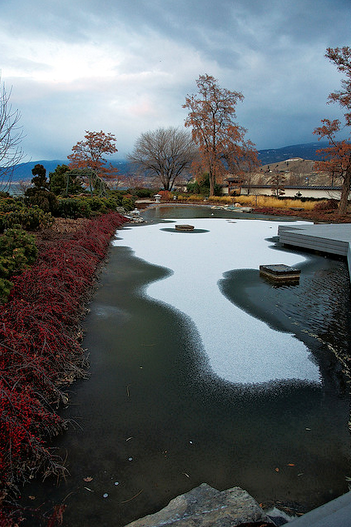Making Your Koi Pond Winter Ready
We’ve said it before and we’ll say it again: koi fish are a big commitment! These long-living fish are costly and their ponds require a lot of maintenance along the way. Keeping up with your koi pond is a must for owners to preserve the wellbeing of your fish. If you live in a seasonal climate, even more maintenance is required to keep your fish friends happy. Read ahead to see how to make your koi pond winter ready!
The Usual Maintenance
Before taking the steps towards koi fish ownership, know that the koi pond will require regular maintenance throughout the year. Water temperature can be monitored easily with a thermometer, as koi do best at 70-82˚ F.
Levels of ammonia, pH, Nitrites, and dissolved water should be tested regularly with water testing kits as well. New ponds should be tested twice a week for the first few months, though after that testing once a week should be safe. These kits are inexpensive and can be found at pet supply stores.
Besides water testing kits, other equipment will require regular maintenance and updates. Be prepared to replace filters every 2 years, water pumps every 3 years, and air pumps every 5 years. Down the line, the pond’s liner will need to be completely taken out and replaced in 20 years.
FALL
Looking ahead to fall, much of the pond care at this time revolves around prepping the pond and fish for winter. Begin by feeding your koi a high protein diet for lasting fuel during this time. Once the cold weather hits, swap the protein for wheat germ. Check out our post on nutrition for more information.
Fall also brings beautiful colors. However, these red and orange leaves have a tendency to clog up ponds. Consider assembling a leaf net or be prepared to scoop out plenty of foliage at this time. Also clip and remove any plants that hang into the waters. Flowers or other floating foliage can be transferred indoors throughout the
Fall is also a time for health check-ups. If any koi seem to be under the weather or acting strange at all, this is the time to treat whatever ailments they may have. When winter comes, the sick may not be strong enough to survive. Check out our post on koi care for more information.
WINTER
For those who enjoy very mild winter temperatures, not much is needed to adapt the pond for those colder months. But for the rest of us, steps will need to be taken to prepare for the winter season.
Because koi’s metabolism is affected by the temperature, their metabolism slows down in the winter to a point where they don’t need to eat. This happens in temperatures under 50˚ F. However, continue to keep the filter on throughout the winter to clean out waste anyhow.
If your pond is deep enough that it will not freeze solid throughout the winter, consider making a cover, such as a pergola, to keep heavy snowfall off the pond. You’ll also want to make sure there is an outlet for gases and air to the pond water. Consider a floating pond deicer or an ice porthole for the pond in winter.
Some koi owners cover and heat their ponds throughout the season. This can be very costly, though it allows koi to grow year-round. You will also be able to enjoy and interact with your koi throughout the winter, that is if you can handle sitting out in the cold!
Is your koi pond ready to handle these upcoming cold months? Begin planning now for an eased transition through the seasons. Getting your koi pond winter ready will be a snap! Do you have any tips on maintaining koi ponds throughout the year? Let us know via the contact form!







